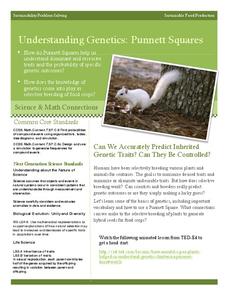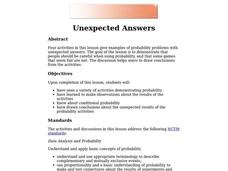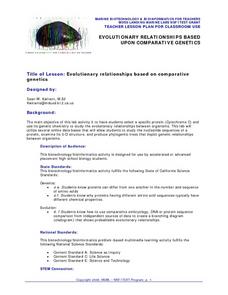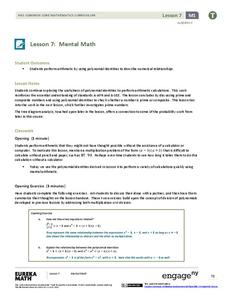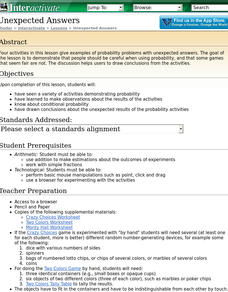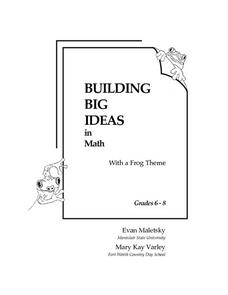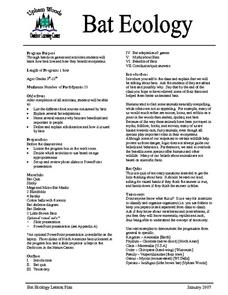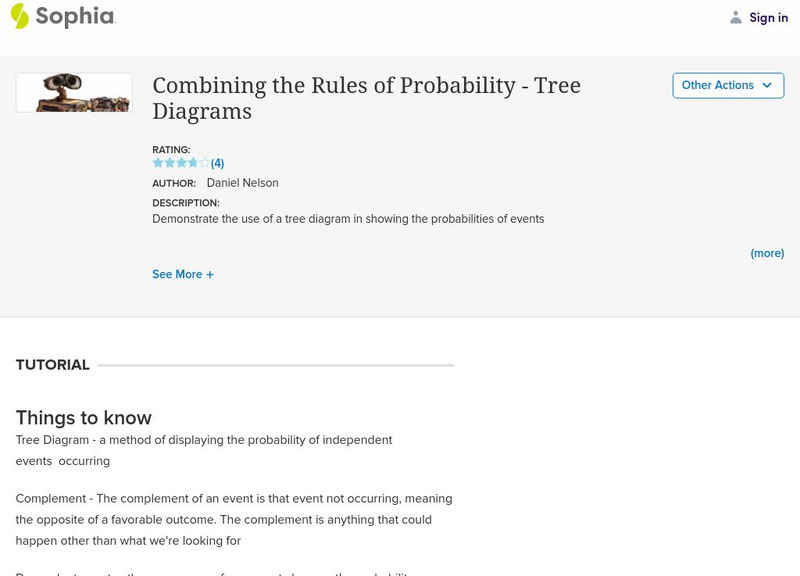Curated OER
Time-Axis Fallacy and Bayes Theorem
Pupils determine that knowledge of an event's outcome can affect the probability of the unknown outcome of an event that has already occurred.
Houghton Mifflin Harcourt
Unit 8 Math Vocabulary Cards (Grade 4)
Enhance fourth graders' math vocabulary with 17 word cards and their definitions. Learners focus on terms that deal with graphing, such as y-axis, coordinates, plot, and ordered pair in the last set of math vocabulary cards.
Curated OER
Cyber Chow Combos
Using a worksheet that's embedded in the plan, elementary schoolers must come up with the most possible combinations of food they can order from the menu on the worksheet. The lesson is meant to be done independently by everyone, then...
Western Kentucky University
Understanding Genetics: Punnett Squares
Can scientists really predict genetic outcomes or are they simply making a lucky guess? Scholars first learn about Gregor Mendel and how to make Punnett squares. Then they extract DNA from a strawberry in a lab with included conclusion...
Curated OER
Unexpected Answers
Students explore and complete a variety of activities demonstration probability. They make observations about the results of the activities. Students complete and discuss conditional probability. Also, students draw conclusions about...
Curated OER
Chaos
Students experiment with several chaotic simulation, they build a working definition of chaos. Students reinforce their knowledge of basic probability and percents. They are reminded of previous knowledge that is pertinent to this...
Curated OER
Matching Pairs
Students examine the probability of the various findings in a game and determine the odds of winning. They differentiate between the facts of odds versus probability. Students use higher order thinking skills to explain how a problem is...
Curated OER
You May Already Be a Winner!
Second graders flip coins and tally the outcomes. They play the You May Already Be a Winner! game with cards under their chairs. Some cards are winners, some might be and the others are not. They play to explain the probability concept.
Curated OER
Probability or Ability?
Students fill in a probability chart while attempting to catch candy with their non-dominant hands. They replicate the activity with a coin.
Curated OER
Evolutionary Relationships Based Upon Comparative Genetics
Students investigate the protein cytochrome c in an attempt to use its genetic chemistry to study possible evolutionary relationships between organisms. The lesson integrates technology with the use computers to perform DNA analysis.
Curated OER
The Fair Factor
Students participate in playing many games to determine if they are fair or not. They create their own game that is fair to play with their classmates.
Curated OER
Brian's Pegboard II
Students are able to assess a problem and use systematic methods to solve the problem. They also find out all the possible outcomes for a sequence of events using tree diagrams.
College Board
Power in Tests of Significance
Test your knowledge of tests of significance. A curriculum model for AP® Statistics describes and defines power in terms of tests of significance. It also provides two classroom activities designed to investigate power and how it relates...
EngageNY
Mental Math
Faster than a speedy calculator! Show your classes how to use polynomial identities to multiply numbers quickly using mental math.
Curated OER
Native American Homes
Fifth graders research and create a model of a Native American home. In pairs, they conduct research on a selected type of Native American home, then draw designs for their building construction. Students then construct their model...
Curated OER
Unexpected Answers
Students consider probability problems with unexpected and surprising answers.
Curated OER
Building Big Ideas in Math With a Frog Theme
In this problem solving instructional activity about frogs, students complete two pages of activities. Students figure out how a frog can hop between lily pads following the rules given. Students draw all possible paths.
Curated OER
Travel Problems
This worksheet is actually an entire chapter focused on math problems involving, shortest path, minimum connector, traveling salesman, and Chinese postman problems. There are multiple activities, exercises, and examples to get students...
Curated OER
Binomial Distribution
Students explore the concept of binomial distribution. In this binomial distribution lesson, students perform binomial distributions on a number of problems in this lecture lesson. Students find the mean and variance of binomial...
Curated OER
Loyalists
Young scholars explain why some colonists remained loyal to England during the American revolution. In this social studies instructional activity, students write a letter to an editor about their reasons for remaining loyal to England.
Curated OER
Bat Ecology
Students, through hands on games and activities, discover how bats live and how bats benefit ecosystems. They play a game designed to show them how echolocation works and another to show how mother bats locate their young through their...
Curated OER
Chapter 11 What's Your Preference
In this math worksheet, learners record the results of a survey taken from family members about relationships and activities.
Curated OER
Search for the Shadowman
Students read the novel "Search for the Shadowman" by Joan Lowery Nixon. Using the internet, they research her life and works and write a report on their findings. They also compare and contrast two of her works to end the lesson plan.
Sophia Learning
Sophia: Combining the Rules of Probability Tree Diagrams
Tree diagrams are the focus of this learning tutorial. The lesson includes important vocabulary along with two videos and PowerPoint presentations that demonstrate how to create tree diagrams with both independent and dependent events.





